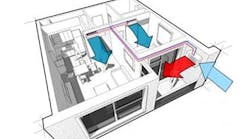by Dominick Guarino
It's amazing how many contractors are still looking for a silver bullet solution to mold. Ideally we would sprinkle some magical pixie dust on a home or building to make it mold-proof, or better yet, to cure all existing mold issues forever.
To find this silver bullet, many flock to mold testing and remediation seminars that promise to provide all the knowledge of an industrial hygienist in just two or three days. Impossible.
Many contractors are getting burned by trying to become mold investigators, or worse, remediatiors. If you're thinking of getting into these professions, do yourself a favor -- set up a completely separate corporation that distances your core company from that work.
When it comes to the reality of dealing with mold, there is no silver bullet -- just common sense, good documentation, good design, and good service and installation practices. With that in mind, there are three basic tenets for dealing with mold issues:
Prevention -- many conditions that lead up to a moldy building can be greatly reduced or eliminated through good design, installation, performance testing, and ongoing maintenance. Testing is key to prevention. Good design is a must, but without testing airflows, temperatures, humidity levels, etc., even the best designs just look good on paper.
Even if the initial source of moisture is a roof or plumbing leak, we can still have a great effect on whether mold spreads or remains contained in the leakage area.
I recently spoke to a contractor about a brand new home with constant 70+% RH in the winter in the Northeast. The problem seems to stem from a wet crawl space and no vapor barrier.
Although the moisture issue isn't the HVAC contractor's fault, he can at least offer some relief, and possibly keep the home from becoming completely infested with growth, by installing a good dehumidification system in the crawl.
In this case, dehumidification shouldn't be sold as a permanent solution or an admission of guilt. The situation should be well-documented since there's a good chance of a lawsuit -- which brings us to the second leg of the stool:
Protection -- the three keys to a good defense when pulled into a mold-related legal situation are documentation, documentation, documentation. Every lawyer I've talked to concurs: If you're not at fault, and you document everything -- conversations, visits, testing results, etc. -- the plaintiff's lawyers hate it!
Another important component of protection is having a company policy and a written protocol for handling moisture-related issues. This ensures consistency among all field people as well as inside staff. Rather than looking for a silver bullet, it might be wiser to spend time working toward making your company more bullet-proof.
Post-Remediation Solutions -- the third leg of the stool is the big business opportunity area in moisture-related situations. Once mold has been identified and remediated by a third party, be a real hero by offering to fix what may have caused the situation to escalate in the first place.
Your customer has just gone through an ordeal they probably don't want to repeat. Price usually isn't an objection at this point -- they just want it done right and get back to their lives.
I'm not talking about fixing roof leaks, leaky pipes, or standing water. Our job is to make sure the comfort system works to minimize airborne moisture and pollutants.
It's not just about adding dehumification, air exchangers, or UV lamps, although each of these products can be part of the solution. The HVAC equipment and the entire air distribution system need to be evaluated.
We need to ask questions like, "Is the equipment sized right? Is it working properly? What about draft and combustion air? Can the duct system deliver air in the right amounts to the right places? Is the distribution system tight and sized right? What else can you do to keep the original problem from resurfacing?"
A word of caution: when a mold remediaton has taken place, before you do anything to the HVAC system, make sure the duct system was cleaned and tested as well.
In several recent mold remediation cases, the ductwork was isolated from the house during cleanup, and no attempt was made to look inside the ducts, which, by the way, were full of mold! An all clear was given for the inside of the home, but after the ducts were reopened, everything was re-contaminated, and the finger-pointing and lawsuits began all over again.
As a contractor, you'll likely be dealing with such situations whether you want to or not. By getting your three-legged stool in place, not only will you sleep better at night, you might just stand to make some well-deserved profit.
Dominick Guarino is chairman and CEO of National Comfort Institute, a national training, certification, and membership organization. He can be reached by phone at 800/633-7058, or by e-mail at [email protected]. For information on NCI, and National Comfort Team, visit www.ncinstitute.com.










